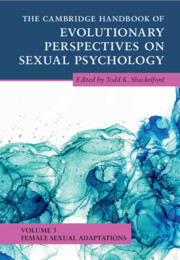Book contents
- The Cambridge Handbook of Evolutionary Perspectives on Sexual Psychology
- The Cambridge Handbook of Evolutionary Perspectives on Sexual Psychology
- Copyright page
- Contents
- Contributors
- Preface
- Part I Precopulatory Adaptations
- Part II Copulatory Adaptations
- Part III Postcopulatory Adaptations
- 13 Mate Retention
- 14 Shifts in Partner Attractiveness
- 15 Emotional Commitment
- 16 Female Sexual Jealousy
- 17 On Attachment and Evolution: Recounting the Story of, and Stories in, Attachment Theory
- 18 Maternal Filicide
- Index
- References
14 - Shifts in Partner Attractiveness
from Part III - Postcopulatory Adaptations
Published online by Cambridge University Press: 30 June 2022
- The Cambridge Handbook of Evolutionary Perspectives on Sexual Psychology
- The Cambridge Handbook of Evolutionary Perspectives on Sexual Psychology
- Copyright page
- Contents
- Contributors
- Preface
- Part I Precopulatory Adaptations
- Part II Copulatory Adaptations
- Part III Postcopulatory Adaptations
- 13 Mate Retention
- 14 Shifts in Partner Attractiveness
- 15 Emotional Commitment
- 16 Female Sexual Jealousy
- 17 On Attachment and Evolution: Recounting the Story of, and Stories in, Attachment Theory
- 18 Maternal Filicide
- Index
- References
Summary
In addition to facilitating reproduction and gene propagation, partner attractiveness facilitates pair-bond maintenance. For this reason, partner attractiveness is a core issue for women’s long-term relationships. In this chapter, in addition to explicating the qualities that comprise partner attractiveness for women and their functions, we discuss the extent to which the functional importance of these qualities may shift situationally within the context of women’s committed, long-term relationships. Traits signaling (a) social status, access to resources, and willingness to share resources and (b) physical health and genetic benefits can confer direct benefits to offspring and thus women’s attraction to such traits can facilitate reproduction. Although research to date suggests women’s attraction to traits signaling social status, access to resources, and willingness to share resources does not shift over contexts or the life-course of women’s long-term relationships, women’s attraction to traits signaling physical health and genetic benefits seem to fluctuate across fertility status (though some mixed evidence has emerged). Moreover, the function of such traits may shift as women’s long-term relationships develop over time. We highlight each of these shifts in turn. Traits signaling commitment and trustworthiness (e.g., commitment, supportiveness, warmth, kindness) facilitate long-term relationship maintenance. Given relationship maintenance is consistently important to women, such partner qualities are a stable component of partner attractiveness; nevertheless, we raise the possibility that women’s attraction to such traits may heighten at key milestones in women’s relationship (e.g., during the transition to parenthood, when reaching older age). We end this chapter by proffering an evolutionary developmental relationship life-course model that (a) synthesizes the literature on shifts in partner attractiveness for women and their implications for women’s relationships, (b) suggests new ways of thinking about partner attractiveness, and (c) reveals gaps in empirical knowledge that can pave the way for future research.
Keywords
- Type
- Chapter
- Information
- Publisher: Cambridge University PressPrint publication year: 2022



